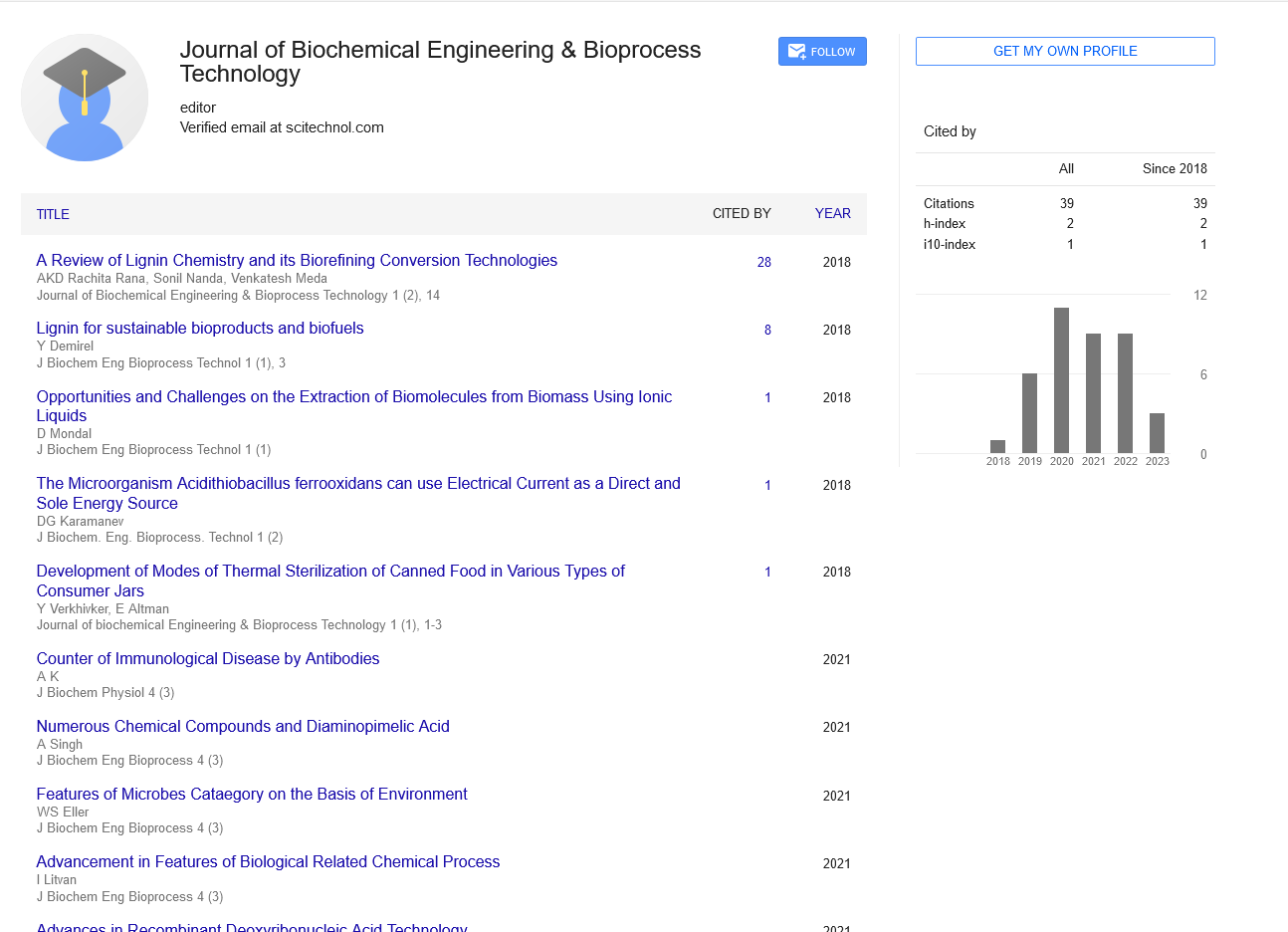Short Communication, J Biochem Eng Bioprocess Vol: 7 Issue: 2
Enzyme Engineering for Enhanced Bioprocess Efficiency: Insights and Innovations
Morgana Ember*
1Department of Biochemical Engineering & Bioprocess Technology, University of Queensland, Brisbane, Australia
*Corresponding Author: Morgana Ember,
Department of Biochemical Engineering
& Bioprocess Technology, University of Queensland, Brisbane, Australia
E-mail: emberm@gmail.com
Received date: 22 May, 2023, Manuscript No. JBEBT-23-106941;
Editor assigned date: 24 May, 2023, Pre QC. JBEBT-23-106941 (PQ);
Reviewed date: 15 June, 2023, QC No. JBEBT-23-106941;
Revised date: 22 June, 2023, Manuscript No. JBEBT-23-106941 (R);
Published date: 29 June, 2023, DOI: 10.35248/jbebt.1000065.
Citation: Ember M (2023) Enzyme Engineering for Enhanced Bioprocess Efficiency: Insights and Innovations. J Biochem Eng Bioprocess 7:2.
Keywords: Bioprocess
Description
Enzyme engineering plays a vital role in enhancing the efficiency of bioprocesses by improving enzyme performance, stability, and specificity. This study aims to provide insights into the recent advancements and innovative strategies employed in enzyme engineering for enhancing bioprocess efficiency. The study explores various approaches such as directed evolution, rational design, and computational modeling that have revolutionized the field of enzyme engineering. Additionally, it discusses the challenges and future prospects of enzyme engineering for bioprocess optimization [1].
Directed evolution: Enhancing enzyme performance
Directed evolution is a widely employed technique in enzyme engineering that mimics the principles of natural selection to evolve enzymes with desired properties. Through random mutagenesis and screening, variants with improved performance can be obtained [2]. This section discusses the various strategies involved in directed evolution, including error-prone PCR, DNA shuffling, and gene recombination. It also highlights successful case studies where directed evolution has led to the development of highly efficient enzymes for specific bioprocesses [3].
Rational design: Tailoring enzymes for specific applications
Rational design involves the modification of enzyme structure and function based on a thorough understanding of their catalytic mechanisms. This section explores the use of protein engineering tools such as site-directed mutagenesis, domain swapping, and protein fusion to tailor enzymes for specific bioprocess applications. It also discusses the integration of computational methods, including molecular docking and molecular dynamics simulations, in guiding rational design strategies [4].
Computational modeling: Predictive tools for enzyme engineering
Computational modeling has emerged as a valuable tool in enzyme engineering, allowing researchers to predict enzyme properties and behavior before experimental validation. This section discusses the application of computational approaches, such as homology modeling, molecular dynamics simulations, and quantum mechanics calculations, in understanding enzyme structure-function relationships. It also highlights how computational modeling can be used to guide enzyme engineering strategies, optimize bioprocess conditions, and predict enzyme stability and specificity [5].
Challenges and future perspectives
Despite the remarkable progress made in enzyme engineering, several challenges remain. This section addresses the limitations of current techniques, including the difficulty in predicting the effects of mutations on enzyme properties accurately. It also discusses the importance of considering multiple factors, such as enzyme-substrate interactions, cofactor availability, and process conditions, in optimizing bioprocess efficiency [6-9]. Furthermore, it highlights emerging areas of research, such as synthetic biology and metagenomics, which hold potential for unlocking new enzymatic activities and expanding the scope of enzyme engineering [10].
Conclusion
Enzyme engineering has revolutionized the field of bioprocess technology by enhancing efficiency, stability, and specificity. The insights and innovations discussed in this study provide a comprehensive overview of the advancements in enzyme engineering. Directed evolution, rational design, and computational modeling have enabled the development of highly efficient enzymes for specific bioprocess applications. While challenges persist, continued research in this field to unlock new opportunities for optimizing bioprocess efficiency and driving sustainable bio-based industries.
References
- Brierley JA, Norris PR, Kelly DP, le Roux NW (1978) Characteristics of a moderately thermophilic and acidophilic iron-oxidizing Thiobacillus. European J Appl Microbiol Biotechnol 5:291–299.
- Norris PR, Brierley JA, Kelly DP (1980) Physiological characteristics of two facultatively thermophilic mineral-oxidising bacteria. FEMS Microbiol Lett 7:119–122.
- Smith PF, Langworthy TA, Smith MR (1975) Polypeptide nature of growth requirement in yeast extract for Thermoplasma acidophilum. J Bacteriol 124:884–892.
[Crossref] [Google Scholar] [PubMed]
- Edwards KJ, Bond PL, Gihring TM, Banfield JF (2000) An Archaeal iron-oxidizing extreme acidophile important in acid mine drainage. Science 287:1796–1799.
[Crossref] [Google Scholar] [PubMed]
- Castelle CJ, Roger M, Bauzan M, et al (2015) The aerobic respiratory chain of the acidophilic archaeon Ferroplasma acidiphilum: A membrane-bound complex oxidizing ferrous iron. Biochim Biophys Acta Bioenerg 1847:717–728.
- Nancucheo I, Johnson DB (2010) Production of glycolic acid by chemolithotrophic Iron and sulfur-oxidizing bacteria and its role in delineating and sustaining acidophilic sulfide mineral-oxidizing consortia. Appl Environ Microbiol 76:461–467.
[Crossref] [Google Scholar] [PubMed]
- Drogui P, Mercier G, Blais J-F (2005) Bioproduction of ferric sulfate used during heavy metals removal from sewage sludge. J Environ Qual 34:816–824.
[Crossref] [Google Scholar] [PubMed]
- Karamanev DG, Nikolov LN, Mamatarkova V (2002) Rapid simultaneous quantitative determination of ferric and ferrous ions in drainage waters and similar solutions. Miner Eng 15:341–346.
- Karamanev DG, Nikolov LN (1988) Influence of some physicochemical parameters on bacterial activity of biofilm: Ferrous iron oxidation by Thiobacillus ferrooxidans. Biotechnol Bioeng 31:295-299.
[Crossref] [Google Scholar] [PubMed]
- Daoud J, Karamanev D (2006) Formation of jarosite during Fe2+ oxidation by Acidithiobacillus ferrooxidans. Miner Eng 19:960–967.
 Spanish
Spanish  Chinese
Chinese  Russian
Russian  German
German  French
French  Japanese
Japanese  Portuguese
Portuguese  Hindi
Hindi 